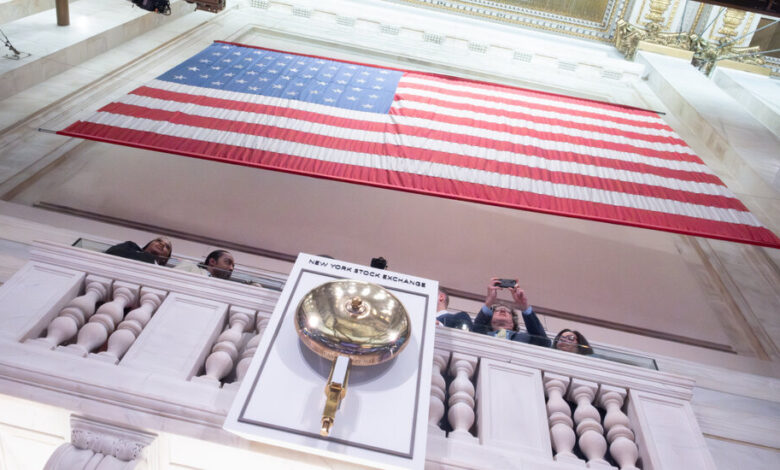Opinion | Stock Ownership Is What Really Divides Americans

In a pamphlet published in 1711, Jonathan Swift lamented the “folly” of those who “mistake the echo of a London coffeehouse for the voice of the kingdom.” Those informal salons were, he wrote, frequented by people whose wealth depended on their shares in the Bank of England or the East India Company or “some other stock.” If the responses to the Trump administration’s tariff policies have shown us anything, it is that, like most of the ills against which Swift railed, this unfortunate tendency to conflate stockholders with the nation remains very much with us.
The greatest division in American life is not between so-called red and blue states, or between urban and rural citizens, but instead between those who own stock and those who do not. For those who do, economic security can be measured in portfolio statements; the rest — roughly 40 percent of Americans — must make do with such antiquated metrics as the cost of housing or even the price of eggs.
This division is not merely economic; it is also ideological. Though many Americans own at least some stock, 10 percent of Americans own 93 percent of it. Yet the elite stock-owning class has convinced itself that what is good for the S&P 500 is good for America. Worse, many Americans who own stock through retirement plans or pension plans have been convinced to believe this, too, even though their interests tend not to align neatly with those of multimillionaires.
The result is a kind of ideological capture in which any policy that does not serve the immediate interests of shareholders is dismissed as reckless, radical or economically illiterate. The common good, insofar as it is considered at all, must first be translated into the language of market returns. Can anything be good if it does not make the line go up? The question (we are told) answers itself.
Like awed visitors to the oracle at Delphi, we consult the Dow Jones and the S&P 500 with solemn credulity, and their half-random fluctuations are taken as portents of divine favor, or else as intimations of the coming wrath of heaven’s gracious ones. All presidents — including Donald Trump — genuflect before this altar, and most of us implicitly regard any policy that displeases the great god Wall Street as a kind of sacrilege. We treat the stock market as the final arbiter of our collective well-being.
But the stock market is not synonymous with the health of the United States. It is not always even a particularly valuable reflection of the state of the economy. Treating it as such not only blinds us to the reality of material conditions; it has also made us incapable of distinguishing between broad-based prosperity and a top-heavy consolidation of wealth. In April 1990, the Dow Jones industrial average stood at 2,710. Despite the no doubt harrowing events of the last week and a half, it is currently at 40,200. Does anyone really believe that Americans are roughly 15 times as wealthy as they were 35 years ago? Even gross domestic product — another debatable metric — is only five times what it was 35 years ago.
Consider a series of alternative measures. In 1970, the median household income was less than $9,000. A new car cost about $3,400 and the average house $26,000. Today, median household incomes have risen to $80,000, but a new vehicle is somewhere in the neighborhood of $49,000, and the average home more than $400,000.
Even these figures do not tell the whole story. The median income half a century ago generally represented the work of a single wage earner, and the prices of automobiles reflected the costs of paying good wages to unionized employees. Today, dual-income households are the norm, and a significant number of cars and trucks are made by nonunion employees, most of them abroad.
These sorts of examples should be considered alongside social pathologies that are not always as easily quantifiable: the proliferation of gig work; the transformation of housing into a speculative asset class; the rise of a quasi-legal cannabis industry, payday lending and online gambling; the decline of reading; the atrophying of attention spans as virtually all facets of modern life are subsumed into digital communications technology. All of these things have, in a sense, been “good for the market.”
In the post-Cold War era, Americans have convinced themselves that economic decision making does not involve value judgments. When policies benefit the stock market, we imagine that they do so in accordance with an unassailable law of nature. But increasing shareholder value is just one possible goal. Another is increasing domestic steel production. Another is shifting the lower middle class away from aspirational “laptop” jobs to skilled trades. These are all political choices, no less than the decision to regulate or to privatize.
A bull market is not evidence of prosperity when real wages stagnate, housing becomes unaffordable, infrastructure crumbles. This is why we should be skeptical when the usual suspects — financial analysts, think-tank denizens, the perpetually aggrieved opponents of Mr. Trump — wring their hands over the supposed damage to “the economy.” What, exactly, is being lamented?
There are any number of possible criticisms — many of them warranted — of Mr. Trump’s erratic tariff policy. But our having spasmodic muscular contractions in the general direction of Wall Street is not one of them. If nothing else good comes from the chaos, the articulation of an overarching national goal that is not simply “making the number go up” would be a small step in the direction of something better.
When John F. Kennedy told the American people that “a rising tide lifts all boats,” one assumes that he did not envision a handful of yachts drifting off into the sunset while an entire fleet of rowboats capsized. That tide has certainly risen.




